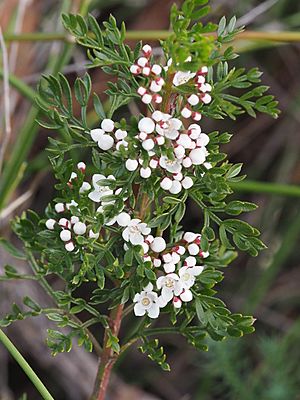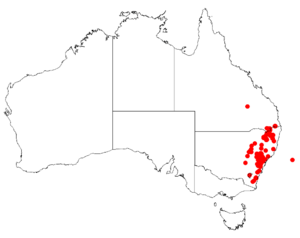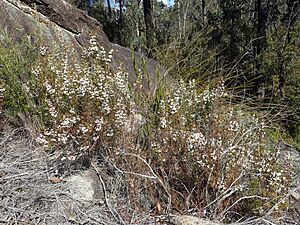Boronia anethifolia facts for kids
Quick facts for kids Narrow-leaved boronia |
|
|---|---|
 |
|
| Boronia anethifolia leaves and flowers | |
| Scientific classification | |
 |
|
| Occurrence data from Australasian Virtual Herbarium |
The Boronia anethifolia, often called the narrow-leaved boronia, is a special plant found only in eastern Australia. It is part of the citrus family, known as Rutaceae. This plant grows as an upright shrub with branches that have four distinct angles. It has unique leaves that are divided into many small parts, and its flowers are usually white, sometimes a pale pink, with four petals.
What Does It Look Like?
The narrow-leaved boronia is an upright shrub that usually grows to be about 0.3–1 m (1–3 ft) tall. Its stems have four clear angles and are smooth, without hairs. The leaves are quite interesting; they are "bipinnate," which means they are divided into smaller leaflets, and then those leaflets are divided again! Each leaf is about 20–40 mm (0.79–1.6 in) long and 15–40 mm (0.59–1.6 in) wide. They have a stalk, called a petiole, that is about 6–15 mm (0.24–0.59 in) long.
Each leaf has between five and eleven smooth, narrow leaflets. The leaflet at the very end is about 3–14 mm (0.1–0.6 in) long and 0.5–2 mm (0.02–0.08 in) wide. The other leaflets are usually a bit longer.

The flowers are typically white, but sometimes you might see pale pink ones. They grow in groups, mostly from three to fourteen or more flowers together. These groups appear where the leaves meet the stem, which is called the leaf axil. Each group of flowers sits on a small stalk, or peduncle, about 2–6 mm (0.08–0.2 in) long.
Each flower has four small, triangular parts called sepals, which are about 1 mm (0.04 in) long and wide. It also has four petals, which are about 3–4 mm (0.1–0.2 in) long and overlap at their bases. Inside the flower, there are eight stamens, which are the parts that produce pollen, and they have tiny hairs along their edges.
This plant usually flowers from April to October. After flowering, it produces smooth fruits that are about 2.5–4 mm (0.098–0.16 in) long and 2 mm (0.079 in) wide.
Its Name and History
The scientific name Boronia anethifolia was first officially described in 1863. This description came from an unpublished work by a botanist named Allan Cunningham. Another botanist, Stephan Endlicher, published the description in a book.
The second part of its name, anethifolia, is quite interesting! It means "dill-leaved." This is because the plant's deeply divided leaves, with their narrow leaflets, look a lot like the leaves of the herb dill (Anethum). Dill belongs to a different plant family called Apiaceae.
Where Does It Grow?
You can find the narrow-leaved boronia growing in different natural areas. It likes to live in heathlands and forests. It also grows on rocky slopes and ridges. Its home stretches from the Border Ranges National Park in Queensland down to Wadbilliga Mountain in southern New South Wales.

